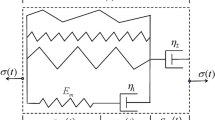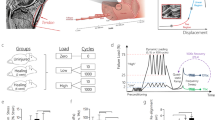Abstract
Tendons exhibit complex viscoelastic behaviors during relaxation and recovery. Recovery is critical to predicting behavior in subsequent loading, yet is not well studied. Our goal is to explore time-dependent recovery of these tendons after loading. As a prerequisite, their strain-dependent viscoelastic behaviors during relaxation were also characterized. The porcine digital flexor tendon was used as a model of tendon behavior. Strain-dependent relaxation was observed in tests at 1, 2, 3, 4, 5, and 6% strain. Recovery behavior of the tendon was examined by performing relaxation tests at 6%, then dropping to a low but nonzero strain level. Results show that the rate of relaxation in tendon is indeed a function of strain. Unlike previously reported tests on the medial collateral ligament (MCL), the relaxation rate of tendons increased with increased levels of strain. This strain-dependent relaxation contrasts with quasilinear viscoelasticity (QLV), which predicts equal time dependence across various strains. Also, the tendons did not recover to predicted levels by nonlinear superposition models or QLV, though they did recover partially. This recovery behavior and behavior during subsequent loadings will then become problematic for both quasilinear and nonlinear models to correctly predict.







Similar content being viewed by others
References
Batson, EL, RJ Paramour, TJ Smith, HL Birch, JC Patterson-Kane, AE Goodship. Are the material properties and matrix composition of equine flexor and extensor tendons determined by their functions? Equine Vet. J. 35(3): 314-318, 2003. doi:10.2746/042516403776148327.
Bonifasi-Lista, C, SP Lake, MS Small, JA Weiss. Viscoelastic properties of the human medial collateral ligament under longitudinal, transverse, and shear loading. J. Orthop. Res. 23: 67-76, 2005. doi:10.1016/j.orthres.2004.06.002.
Boyce, BL, RE Jones, TD Nguyen, JM Grazier. Stress-controlled viscoelastic tensile response of bovine cornea. J. Biomech. 40: 2367-2376, 2007. doi:10.1016/j.jbiomech.2006.12.001.
Cheng, T and RZ Gan. Mechanical properties of stapedial tendon in human middle ear. J. Biomech. Eng. 129: 913-918, 2007. doi:10.1115/1.2800837.
Ciarletta, P, S Micera, D Accoto, P Dario. A novel microstructural approach in tendon viscoelastic modeling at the fibrillar level. J. Biomech. 39: 2034-2042, 2006. doi:10.1016/j.jbiomech.2005.06.025.
Crisco, J, S Chelikani, R Brown, S Wolfe. The effect of exercise on ligamentous stiffness of the wrist. J. Hand Surg. 22A: 44-48, 1997.
Doehring, TC, AD Freed, EO Carew, I Vesely. Fractional order viscoelasticity of the aortic valve cusp: an alternative to quasilinear viscoelasticity. J. Biomech. Eng. 127(4): 700-708, 2005. doi:10.1115/1.1933900.
Eckstrom, L, A Kaigle, E Hult, S Holm, M Rostgat, T Hansson. Intervertebral disc response to cyclic loading: an animal model. Proc. Inst. Mech. Eng. 210:249-258, 1996. doi:10.1243/PIME_PROC_1996_210_421_02.
Elliot, DM, PS Robinson, JA Gimbel, JJ Sarver, JA Abboud, RV Iozzo, LJ Soslowsky. Effect of altered matrix proteins on quasilinear viscoelastic properties in transgenic mouse tail tendons. Ann. Biomed. Eng. 31: 599-605, 2003. doi:10.1114/1.1567282.
Gedalia, U, M Solomonow, B Zhou, R Baratta, Y Lu, M Harris. Biomechanics of increased exposure to lumbar injury caused by cyclic loading II: recovery of reflexive muscular stability with rest. Spine 24(23): 2461-2467, 1999. doi:10.1097/00007632-199912010-00007.
Graf, BK, R Vanderby, MJ Ulm, RP Rogalski, RJ Thielke. Effect of preconditioning on the viscoelastic response of primate patellar tendon. Arthroscopy 10(1):90-96, 1994.
Han, S, SJ Gemmell, KG Helmer, P Grigg, JW Wellen, AH Hoffman, CH Sotak. Changes in ADC caused by tensile loading of rabbit achilles tendon: evidence for water transport. J. Mag. Reson. 144: 217-227, 2000. doi:10.1006/jmre.2000.2075.
Hingorani, RV, PP Provenzano, RS Lakes, A Escarcega, R Vanderby. Nonlinear viscoelasticity in rabbit medical collateral ligament. Ann. Biomed. Eng. 32(2): 306-312, 2004. doi:10.1023/B:ABME.0000012751.31686.70.
Hirpara, KM, PJ Sullivan, ME O’Sullivan. The effects of freezing on the tensile properties of repaired porcine flexor tendon. J. Hand Surg. 33A: 353-358, 2008. doi:10.1016/j.jhsa.2007.12.011.
Lakes, R. S. Viscoelastic Materials. Cambridge: Cambridge University Press, 2009
Lakes, RS, and R Vanderby. Interrelation of creep and relaxation: a modeling approach for ligaments. J. Biomech. Eng. 121: 612-615, 1999. doi:10.1115/1.2800861.
Ledoux, WR, DF Meaney, HJ Hillstrom. A quasi-linear, viscoelastic, structural model of the plantar soft tissue with frequency-sensitive damping properties. J. Biomech. Eng. 126(6): 831-837, 2004. doi:10.1115/1.1824133.
Lieber, RL, ME Leonard, CG Brown, CL Trestik. Frog semitendinosis tendon load-strain and stress-strain properties during passive loading. Am. J. Phys. 261: C86-C92, 1991.
Lin, Y, GH Koenderink, FC MacKintosh, DA Weitz. Viscoelastic properties of microtubules. Macromolecules 40(21): 7714-7720, 2007. doi:10.1021/ma070862l.
Magnusson, SP, P Aagaard, JJ Nielson. Passive energy return after repeated stretches of the hamstring muscle-tendon unit. Med. Sci. Sports Exerc. 32(6): 1160-1164, 2002. doi:10.1097/00005768-200006000-00020.
McGill, S, and S Brown. Creep response of lumbar spine to prolonged full flexion. Clin. Biomech. 7:43-46, 1992. doi:10.1016/0268-0033(92)90007-Q.
Moon, DK, SL Woo, Y Takakura, MT Gabriel, SD Abramowitch. The effects of refreezing on the viscoelastic and tensile properties of ligaments. J. Biomech. 39: 1153-1157, 2006. doi:10.1016/j.jbiomech.2005.02.012.
Mow, VC, AF Mak, WM Lai, LC Rosenberg, LH Tang. Viscoelastic properties of proteoglycan subunits and aggregates in varying solution concentrations. J. Biomech. 17(5): 325-38, 1984. doi:10.1016/0021-9290(84)90027-7.
Mow, VC, W Zhu, WM Lai, TE Hardingham, C Hughes, H Muir. The influence of link protein stabilization on the viscometric properties of proteoglycan aggregate solutions. Biochim Biophys Acta 992(2): 201-208, 1989.
Navajas, D, GN Maksym, JHT Bates. Dynamic viscoelastic nonlinearity of lung parenchymal tissue. J. Appl. Physiol. 79(1): 348-356, 1995.
Nekouzadeh, A, KM Pryse, EL Elson, GM Genin. A simplified approach to quasilinear viscoelastic modeling. J. Biomech. 40(14): 3070-3078, 2007. doi:10.1016/j.jbiomech.2007.03.019.
Oza, A, R Vanderby, RS Lakes. Interrelation of creep and relaxation for nonlinearly viscoelastic materials: application to ligament and metal. Rheol. Acta 42: 557-568, 2003. doi:10.1007/s00397-003-0312-0.
Provenzano, P, D Heisey, K Hayashi, R Lakes, R Vanderby. Subfailure damage in ligament: a structural and cellular evaluation. J. Appl. Phys. 92: 362-371, 2002.
Provenzano, P, R Lakes, T Keenan, R Vanderby. Nonlinear ligament viscoelasticity. Ann. Biomed. Eng. 29: 908-914, 2001. doi:10.1114/1.1408926.
Rumian, AP, AL Wallace, HL Birch. Tendons and ligaments are anatomically distinct but overlap in molecular and morphological features – a comparative study in an ovine model. J. Orthop. Res. 25(4): 458-464, 2007. doi:10.1002/jor.20218.
Shadwick, RE. Elastic energy storage in tendons: mechanical differences related to function and age. J. Appl. Physiol. 68(3): 1033-1040, 1990. doi:10.1063/1.346741.
Solomonow, M, BH Zhou, RV Baratta, Y Lu, M Zhu, M Harris. Biexponential recovery model of lumbar viscoelasticity and reflexive muscular activity after prolonged cyclic loading. Clin. Biomech. 15:167-175, 2000. doi:10.1016/S0268-0033(99)00062-5.
Sverdlik, A. and Y Lanir. Time-dependent mechanical behavior of sheep digital tendons, including the effects of preconditioning. J. Biomech. Eng. 124: 78-84, 2002. doi:10.1115/1.1427699.
van Dommelen, JAW, MM Jolandan, BJ Ivarsson, SA Millington, M Raut, JR Kerrigan, JR Crandall, DR Diduch. Nonlinear viscoelastic behavior of human knee ligaments subjected to complex loading histories. Ann. Biomed. Eng. 34(6):1008-1018, 2006. doi:10.1007/s10439-006-9100-1.
Woo, SL-Y, MA Gomez, WH Akeson. The time and history dependent viscoelastic properties of the canine medial collateral ligament. J. Biomech. Eng 103: 293-298, 1981.
Yang, W, TC Fung, KS Chian, CK Chong. Viscoelasticity of esophageal tissue and application of QLV model. J. Biomech. Eng. 128(6): 909-916, 2006. doi:10.1115/1.2372473.
Zhang, C, and ID Moore. Nonlinear mechanical response of high density polyethylene. Part 1: experimental investigation and model evaluation. Polym. Eng. Sci. 37(2): 404-413, 1997. doi:10.1002/pen.11683.
Acknowledgments
This work was funded by NSF award 0553016. The authors thank Ron McCabe for his technical assistance.
Author information
Authors and Affiliations
Corresponding author
Rights and permissions
About this article
Cite this article
Duenwald, S.E., Vanderby, R. & Lakes, R.S. Viscoelastic Relaxation and Recovery of Tendon. Ann Biomed Eng 37, 1131–1140 (2009). https://doi.org/10.1007/s10439-009-9687-0
Received:
Accepted:
Published:
Issue Date:
DOI: https://doi.org/10.1007/s10439-009-9687-0




